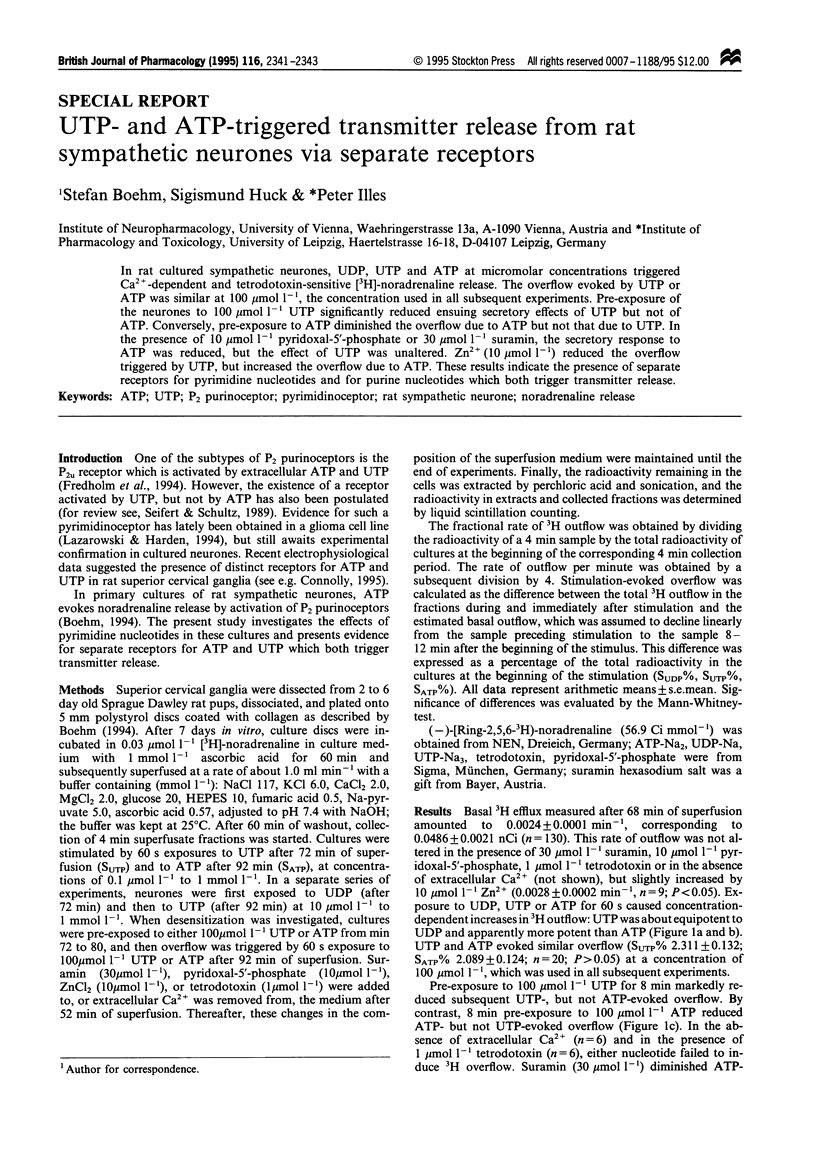Abstract
In rat cultured sympathetic neurones, UDP, UTP and ATP at micromolar concentrations triggered Ca(2+)-dependent and tetrodotoxin-sensitive [3H]-noradrenaline release. The overflow evoked by UTP or ATP was similar at 100 mumol l-1, the concentration used in all subsequent experiments. Pre-exposure of the neurones to 100 mumol l-1 UTP significantly reduced ensuing secretory effects of UTP but not of ATP. Conversely, pre-exposure to ATP diminished the overflow due to ATP but not that due to UTP. In the presence of 10 mumol l-1 pyridoxal-5'-phosphate or 30 mumol l-1 suramin, the secretory response to ATP was reduced, but the effect of UTP was unaltered. Zn2+ (10 mumol l-1) reduced the overflow triggered by UTP, but increased the overflow due to ATP. These results indicate the presence of separate receptors for pyrimidine nucleotides and for purine nucleotides which both trigger transmitter release.
Full text
PDF


Selected References
These references are in PubMed. This may not be the complete list of references from this article.
- Barry V. A., Cheek T. R. Extracellular ATP triggers two functionally distinct calcium signalling pathways in PC12 cells. J Cell Sci. 1994 Feb;107(Pt 2):451–462. doi: 10.1242/jcs.107.2.451. [DOI] [PubMed] [Google Scholar]
- Boehm S. Noradrenaline release from rat sympathetic neurons evoked by P2-purinoceptor activation. Naunyn Schmiedebergs Arch Pharmacol. 1994 Nov;350(5):454–458. doi: 10.1007/BF00173013. [DOI] [PubMed] [Google Scholar]
- Cloues R., Jones S., Brown D. A. Zn2+ potentiates ATP-activated currents in rat sympathetic neurons. Pflugers Arch. 1993 Jul;424(2):152–158. doi: 10.1007/BF00374606. [DOI] [PubMed] [Google Scholar]
- Connolly G. P. Differentiation by pyridoxal 5-phosphate, PPADS and IsoPPADS between responses mediated by UTP and those evoked by alpha, beta-methylene-ATP on rat sympathetic ganglia. Br J Pharmacol. 1995 Feb;114(3):727–731. doi: 10.1111/j.1476-5381.1995.tb17199.x. [DOI] [PMC free article] [PubMed] [Google Scholar]
- Dunn P. M., Blakeley A. G. Suramin: a reversible P2-purinoceptor antagonist in the mouse vas deferens. Br J Pharmacol. 1988 Feb;93(2):243–245. doi: 10.1111/j.1476-5381.1988.tb11427.x. [DOI] [PMC free article] [PubMed] [Google Scholar]
- Fredholm B. B., Abbracchio M. P., Burnstock G., Daly J. W., Harden T. K., Jacobson K. A., Leff P., Williams M. Nomenclature and classification of purinoceptors. Pharmacol Rev. 1994 Jun;46(2):143–156. [PMC free article] [PubMed] [Google Scholar]
- Lazarowski E. R., Harden T. K. Identification of a uridine nucleotide-selective G-protein-linked receptor that activates phospholipase C. J Biol Chem. 1994 Apr 22;269(16):11830–11836. [PubMed] [Google Scholar]
- Seifert R., Schultz G. Involvement of pyrimidinoceptors in the regulation of cell functions by uridine and by uracil nucleotides. Trends Pharmacol Sci. 1989 Sep;10(9):365–369. doi: 10.1016/0165-6147(89)90009-6. [DOI] [PubMed] [Google Scholar]
- Trezise D. J., Bell N. J., Khakh B. S., Michel A. D., Humphrey P. A. P2 purinoceptor antagonist properties of pyridoxal-5-phosphate. Eur J Pharmacol. 1994 Jul 11;259(3):295–300. doi: 10.1016/0014-2999(94)90656-4. [DOI] [PubMed] [Google Scholar]
- von Kügelgen I., Starke K. Evidence for two separate vasoconstriction-mediating nucleotide receptors, both distinct from the P2x-receptor, in rabbit basilar artery: a receptor for pyrimidine nucleotides and a receptor for purine nucleotides. Naunyn Schmiedebergs Arch Pharmacol. 1990 Jun;341(6):538–546. doi: 10.1007/BF00171734. [DOI] [PubMed] [Google Scholar]


